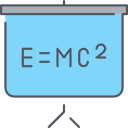
Skripsi
INTERAKSI SENYAWA QUERCETIN DARI RHODOMYRTUS TEMENTOSA DENGAN TUMOR NECROTIZING FACTOR ALFA (TNF-α) PADA DIABETES MELITUS TIPE II : ANALISA BIOINFORMATIKA
Penilaian
0,0
dari 5Background: Indonesia ranks 7th out of 10 countries in the world with the highest number of people with diabetes. In type 2 DM TNF-α contributes to the development of insulin resistance, which accounts for 90-95% of cases of this disease. Karamunting (Rhodomyrtus tomentosa) is one of the plants that has medicinal value, with more than 100 compounds, Quercetin is one of the compounds that has antioxidant, anticancer, antibacterial, and anti-inflammatory activities. Along with the times bioinformatics has become one of the research methods in finding drug candidates with in silico methods. This study aims to determine how bioinformatically the potential target of quercetin compounds from the Karamunting plant (Rhodomyrtus tomentosa) and its interaction with the cytokine TNF-α which plays a role in one of the pathogenesis of insulin resistance. Method: The research method used in this research is descriptive explorative in silico. The in silico technique refers to research through computer simulations and the availability of databases, software and web servers using software such as Cytoscape, Pyrx, Autodock Tools, and Biova Discovery Studio. Results: Based on the results of the analysis of druglikeness prediction using Lipinski's rule of five, quercetin bioactive substances meet all the criteria and have no violations. Based on topology analysis we obtained INS, AKT1, IL6, ALB, STAT3, GLUT4/SLCA2A4, and TNF can be potential targets for quercetin. The docking analysis showed that the binding affinity of quercetin and TNF-α complex was -8.8 kcal/mol. This energy is higher than the binding affinity of the target protein with the comparator ligand which is around -13.2 kcal/mol. In the interaction visualization of the docking results, it was found that quercetin has similar interactions with the comparator ligand on the allosteric side of the receptor. Based on the interaction results, it can be concluded that quercetin has the same bioactivity as the comparator ligand, so it can be used as a compound that has the potential to be developed as a TNF-α inhibitor. Conclusion: Quercetin from the docking results does not have a lower binding affinity than the comparator ligand, but the interaction results show a similar bioactivity that makes quercetin potentially developed as a TNF-α blocker. Quercetin also fulfills the Lipinski criteria, which indicates that quercetin has the potential to be used as an oral drug. Keywords. Diabetes Melitus Type II, TNF-α, Quercetin, In Silico
Availability
| Inventory Code | Barcode | Call Number | Location | Status |
|---|---|---|---|---|
| 2407000422 | T137046 | T1370462023 | Central Library (Referens) | Available but not for loan - Not for Loan |
Detail Information
- Series Title
-
-
- Call Number
-
T1370462023
- Publisher
- Inderalaya : Prodi Pendidikan Dokter, Fakultas Kedokteran Universitas Sriwijaya., 2023
- Collation
-
xviii, 95 hlm.; Ilus.; 29 cm
- Language
-
Indonesia
- ISBN/ISSN
-
-
- Classification
-
616.460 7
- Content Type
-
Text
- Media Type
-
unmediated
- Carrier Type
-
-
- Edition
-
-
- Subject(s)
- Specific Detail Info
-
-
- Statement of Responsibility
-
SEPTA
Other version/related
No other version available
File Attachment
Comments
You must be logged in to post a comment
 Computer Science, Information & General Works
Computer Science, Information & General Works  Philosophy & Psychology
Philosophy & Psychology  Religion
Religion  Social Sciences
Social Sciences  Language
Language  Pure Science
Pure Science  Applied Sciences
Applied Sciences  Art & Recreation
Art & Recreation  Literature
Literature  History & Geography
History & Geography